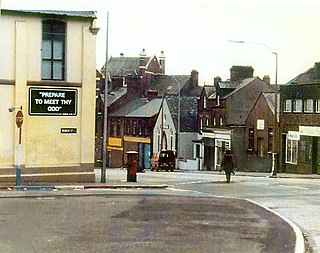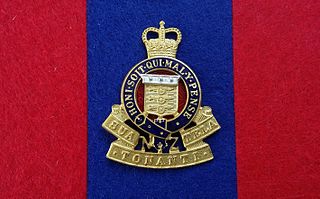
Warrant officer (WO) is a rank or category of ranks in the armed forces of many countries. Depending on the country, service, or historical context, warrant officers are sometimes classified as the most junior of the commissioned officer ranks, the most senior of the non-commissioned officer (NCO) ranks, or in a separate category of their own. Warrant officer ranks are especially prominent in the militaries of Commonwealth nations and the United States.
Sergeant major is a senior non-commissioned rank or appointment in many militaries around the world.
Company quartermaster sergeant is a military rank or appointment.

"Other ranks" is the term used to refer to all ranks below officers in the British Army and the Royal Marines. It includes warrant officers, non-commissioned officers ("NCOs") and ordinary soldiers with the rank of private or regimental equivalent. Officers may, in speaking, distinguish themselves from those "in the ranks".
Staff sergeant major is an appointment in some Commonwealth armies and also a rank in the Royal Canadian Mounted Police.

The Royal Army Service Corps (RASC) was a corps of the British Army responsible for land, coastal and lake transport, air despatch, barracks administration, the Army Fire Service, staffing headquarters' units, supply of food, water, fuel and domestic materials such as clothing, furniture and stationery and the supply of technical and military equipment. In 1965 its functions were divided between other Corps and the RASC ceased to exist; subsequently, in 1993, they in their turn became the "Forming Corps" of the Royal Logistic Corps.

The Royal Army Ordnance Corps (RAOC) was a corps of the British Army. At its renaming as a Royal Corps in 1918 it was both a supply and repair corps. In the supply area it had responsibility for weapons, armoured vehicles and other military equipment, ammunition and clothing and certain minor functions such as laundry, mobile baths and photography. The RAOC was also responsible for a major element of the repair of Army equipment. In 1942 the latter function was transferred to the Royal Electrical and Mechanical Engineers (REME) and the vehicle storage and spares responsibilities of the Royal Army Service Corps were in turn passed over to the RAOC. The RAOC retained repair responsibilities for ammunition, clothing and certain ranges of general stores. In 1964 the McLeod Reorganisation of Army Logistics resulted in the RAOC absorbing petroleum, rations and accommodation stores functions from the Royal Army Service Corps as well as the Army Fire Service, barrack services, sponsorship of NAAFI (EFI) and the management of staff clerks from the same Corps. On 5 April 1993, the RAOC was one of the corps that amalgamated to form The Royal Logistic Corps (RLC).
Like the British Army, the Australian Army does not use the term 'enlisted' to describe its non-commissioned ranks. Instead, personnel who are not commissioned officers are referred to as other ranks. These are soldiers, non-commissioned officers (NCOs) and warrant officers (WOs). Warrant officers are appointed by a warrant which is signed by the Chief of the Army. The insignia for non-commissioned ranks are identical to the British Army up to the rank of warrant officer class two. Since 1976, WO1s and the WO in the Australian Army wear insignia using the Australian Coat of Arms.
An ammunition technician (AT) is a British Army soldier, formerly of the Royal Army Ordnance Corps but since 1993 of the Royal Logistic Corps, trained to inspect, repair, test, store, and modify all ammunition, guided missiles, and explosives used by the British Army. These technicians are also trained to use demolition to safely dispose of individual items of ammunition and explosives (EODs) or to conduct logistics disposal of bulk stocks of multi items. After gaining sufficient experience, those who show the appropriate qualities are given extra training to render safe improvised explosive devices (IEDs) by a process called improvised explosive device disposal. Experienced ATs may be called to give evidence as expert witnesses in criminal or coroner's courts in relation to ammunition or explosives or to EOD and IEDD duties.

An ammunition technical officer (ATO) is an officer involved in all aspects of the army, air force, and navy's use of ammunition. This includes: bomb disposal, clearance of ERW, explosives accident investigation, procurement, in service management, storage, and inspection and repair.

The Royal Australian Army Ordnance Corps (RAAOC) is the Corps within the Australian Army concerned with supply and administration, as well as the demolition and disposal of explosives and salvage of battle-damaged equipment. The Corps contains clerks, operator supplies, petroleum operators, parachute riggers and ammunition technicians. Members of the Corps are nicknamed Roaches.

A bandmaster is the leader and conductor of a band, usually a concert band, military band, brass band or a marching band.

A Senior Enlisted Advisor (SEA) in the United States Armed Forces is the most senior enlisted service member in a unit, and acts as an advisor to the commanding officer. Formally, E-9 billets for the senior enlisted advisor are established at Service unit, command, major command, force, or fleet levels to the SEAs/CSELs of DoD Agencies and the Senior Enlisted Advisor to the Chairman of the Joint Chiefs of Staff. SEAs are also known as Command Senior Enlisted Leaders (CSEL). Always a non-commissioned officer, the SEA is the main link between the commanding officer and the enlisted service members under his or her charge.

A warrant officer (WO) in the British Armed Forces is a member of the highest-ranking group of non-commissioned ranks, holding the King's Warrant, which is signed by the Secretary of State for Defence.

Regimental Sergeant Major of the Army (RSM-A) is the most senior Warrant Officer in the Australian Army. It is a singular appointment – it is only held by one person at any time. RSM-A holds the unique rank of Warrant Officer (WO) which is senior to Warrant Officer Class One. The special insignia for the RSM-A is the Australian coat of arms with a wreath around it. The twelfth and current Regimental Sergeant Major of the Army is Kim Felmingham.

The Army Sergeant Major is the most senior member of the other ranks of the British Army.
The 1940 Birthday Honours were appointments by King George VI to various orders and honours to reward and highlight good works by citizens of the British Empire. The appointments were made to celebrate the official birthday of The King, and were published on 9 July 1940.

The Royal New Zealand Army Ordnance Corps (RNZAOC) concerned itself with the provisioning of troops with the means to fight; specifically uniforms, weapons and equipment. Ordnance functions go back hundreds of years; the first Ordnance Officer in the British military appeared in the year 1299. Designated "Keeper of the King's Wardrobe", his duties included the care and accounting of heavy equipment such as battering rams and catapults.
Logistic Specialist is the Royal New Zealand Army Logistic Regiment trade responsible for providing Supply & Quartermaster support to the New Zealand Army within New Zealand or overseas.












